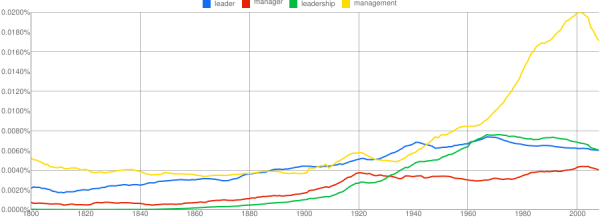Unless you are prepared to see things differently and go against the current, you are unlikely to accomplish anything truly important. And to go against the current, you have to be something of an outsider, living on the edge, a member of a small but vibrant counterculture. You must free yourself from habitual ways of looking at things, cultivate an independent and questioning perspective, and be ready to embrace alternative and counterintuitive points of view.
Dove Frohman in Leadership the Hard Way: Why Leadership Can’t Be Taught – And How You Can Learn It Anyway (J-B Warren Bennis Series)
Management Since 1800
I’m a proponent of leadership over management as the primary course of study to improve one’s ability to influence people. Management, however, seems to have reigned as a subject in books since the 1800s. The google Ngram below charts the usage of the keywords “manager,” “leader,” “management”, and “leadership” in books since 1800.
I notice a couple of interesting things about these trends:
- Leadership subjects did not appear until the mid 1800s (perhaps as a result of the American Civil War)
- Management subjects decreased during the America’s Great Depression
- Management subjects skyrocketed during 1970-1990 (the rise in the economies of industrialized countries)
- All of the keywords dropped in usage after 2001 (Influenced by the attacks on September 11?)
Humility, the Basic Leadership Virtue
Benedict believed the basic leadership virtue was humility. Leaders had to demonstrate competence and ambition, but their passion was to derive from a desire to improve and contribute to the health of the organization, not from individual ego. He believed that true humility was a skill one had to learn and practice.
John Mount, in a Forbes.com review of the book The Benedictine Rule of Leadership: Classic Management Secrets You Can Use Today
by Craig and Oliver Galbraith
Greenleaf on Servant Leadership
The great leader is seen as the servant first. – Robert K. Greenleaf
Kotter: Great Leaders Have Emotional Impact
Great leaders tell stories that create pictures in our minds and have emotional impact. Martin Luther King Jr., had a dream, not a strategy or a goal, and he showed us his dream, his picture of the future. People change when they see something visual (the vision) that touches their feelings, challenges their thinking, and incites actions. People may realize the need for change, but not do anything differently because they lack the passion to break out of the routines or habit patterns. The momentum of ‘how we’ve done things’ tends to make our future look like our past.
The ability to move people emotionally is a special gift. Few of us are born with it, but we can learn it. John P. Kotter
Leadership Lessons From A Janitor
 The following leadership lesson was circulated around our organization today. I’ve read this before, was inspired, and moved on to the popular leadership theories and acronyms of more “modern” leader training. But this is a story that deserves to be revisited often, it teaches lessons lacking in today’s leaders. In an article published in the Warton Leadership Digest James E. Moschgat (at the time a Colonel in Command of the 12th Operations Group, 12th Flying Training Wing, Randolph Air Force Base, Texas) writes about the squadron janitor at the Air Force Academy who was discovered to be a Congressional Medal of Honor winner. The janitor was William John Crawford who earned a Medal of Honor while serving in Italy with the 36th Infantry Division but went on to become a leadership inspiration to Colonel Moschgat. (more…)
The following leadership lesson was circulated around our organization today. I’ve read this before, was inspired, and moved on to the popular leadership theories and acronyms of more “modern” leader training. But this is a story that deserves to be revisited often, it teaches lessons lacking in today’s leaders. In an article published in the Warton Leadership Digest James E. Moschgat (at the time a Colonel in Command of the 12th Operations Group, 12th Flying Training Wing, Randolph Air Force Base, Texas) writes about the squadron janitor at the Air Force Academy who was discovered to be a Congressional Medal of Honor winner. The janitor was William John Crawford who earned a Medal of Honor while serving in Italy with the 36th Infantry Division but went on to become a leadership inspiration to Colonel Moschgat. (more…)
Leader Poet
The Maxwell Leadership Bible counts the leadership style in the United States since World War II. There has been an evolution of leadership styles over the past sixty years which illustrates the change in the generations and a move to more internalized and inspired followers.
1. Military Commander. Leaders returned from the war emulating the leadership styles that won the war. They implemented a top down dictatorship style influencing from their position as a leader instead of inspiration.
2. Chief Executive Officer. CEOs lead through vision, goals and objectives passed to subordinates to follow. This is a top down leadership style which depends more on execution of a strict plan than
3. Coaches. Recently, leaders have viewed themselves as coaches of a team striving together for a win. In a sports obsessed society this works well because it focuses on the teams strengths and weaknesses forms
4. Poets. Currently more leaders are realizing the power of words and the inspirational value of empowering subordinates. A leader poet knows with a properly formed message subordinates will be empowered to creatively achieve the organizations goals. See also: Motivation 3.0
…all the people hung on [Jesus’] words (Luke 19:48 NIV
The Path of the Warrior
A warrior is a person experienced in or capable of engaging in combat or warfare, literally or figuratively. Most leaders are figurative warriors, those who show great vigor, courage, or aggressiveness in everyday challenges. Merely acting like a warrior is insufficient, a warrior leader must become one by consistently walking the path of:
1. Integrity – honest and sincere
2. Impeccability – faultless character
3. Outrageous – excessively bold
4. Personal Power – ability to act
The leader shows that style is not more important than substance, and that creating an impression is not more potent than acting from one’s center – Lao Tzu (500BC)
Truthfulness
Arrogant [Eloquent] lips are unsuited to a fool
how much worse lying lips to a ruler! Proverbs 17:5-7 (NIV)
Truthfulness is an elusive habit for leaders. We are assaulted daily by situations that beg for lies, half-truths, misinformation, deception, and withholding. These situations arise at work from difficult communication, positions of disadvantage to us, and fear of retribution. Within our families they arise from personal pride toward spouses, fear of children’s actions, and discomfort with admitting to wrong actions.
The mad boss asks, “Who made this decision?”
The Christian brother states, “I’m only flirting with her, I can control it.”
The inefficient employee asks, “Am I doing ok working for you?”
The spouse demands, “Where did all of our money go?”
Your child asks, “Where do babies come from?”
A Christian Leader’s response:
1. Just tell it. The benefits of truthfulness outweigh the costs in the long run as your boss learns to appreciates your trust and candor, your spouse loves the open communication, and your children model. Warning, blunt truthfulness will mark you as a jerk and harm your ability to influence. Use gentleness and patience to form your communication in a way that creates an environment of appreciation.
2. Demand it in return. My initial briefing to new employees has always included the requirement of truth. My nature I am a trusting person, tell me something and I take it to the bank until that something is proven false. Once you lose my trust it’s hard to get it back. My daughters were raised with the same requirement. I marvel at parents who severely discipline children based on honest disclosure. Since birth we have demanded truth and lessened discipline with it. The result, open communication… something seemingly rare in today’s youth.
To be persuasive we must be believable; to be believable we must be credible; credible we must be truthful. Edward R. Murrow
New Leader Top Five
I recently hired a new leader for a regional area of our large sales type organization. During our initial meeting he and I discussed my expectations, talked about the vision for the organization, my leadership philosphy, and near term goals for his area. I also provided him with a concise list of the top five things he could do to get off to a good start with his subordinate leaders:
- Be clear on what you expect and recognize those who meet or miss it
- Be available when and where it matters most
- Be an advocate for your subordinates without being an enabler of bad behavior/excuses. Be prepared to say “no” when “no” is warranted.
- Be informed. Track details two levels down
- Be a leader. Don’t expect subordinates to adjust to the leadership style you’re comfortable with, adapt your leadership techniques to gain the most influence.
Of course leadership is more complex than just five things, but when taking over a new position it’s easy to get disctacted with all of the information and decisions required. These five things provide the new leader with a framework to build on future success as operations start to syncronize and get into a rythmn enabling them to build on what they initially established.


